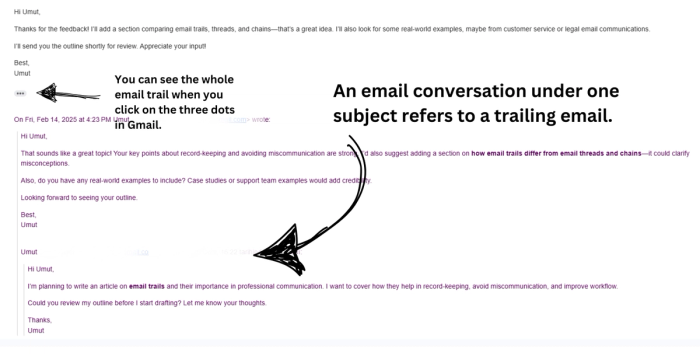What is Email Trailing? Understanding Trailing Mail and Its Meaning
An email trail is the chronological sequence of emails in a conversation, a complete history of exchanges.
It includes all original messages, replies, forwards, and attachments, serving as a record for reference, audits, or legal reviews.
For example, a legal team might analyze an email trail to verify contract negotiations over time.
What Does "Email Trailing" Mean?
Email trailing refers to the record of all ongoing communication within a single email subject, including sent, received, and forwarded messages.
It helps maintaining context, track discussions, and transparency in professional and personal correspondence.
For instance, a manager might trail emails to ensure accountability during a project handoff.
What is the Meaning of "Trailing Mail"?
The term "trailing mail" is occasionally used in Indian English to describe a series of emails in a conversation.
However, it’s non-standard in formal English, where “email trail” or “thread” is preferred.
Trailing email refers to the record of all emails that have been sent, replied to, and forwarded in a single conversation.
It implies a record of exchanges, such as a customer support case history.

Email Thread vs. Email Trail vs. Email Chain
| Term | Definition | Context |
|---|---|---|
| Email Thread | A connected series of emails under one subject line, focusing on ongoing dialogue. | Team projects, customer support (e.g., resolving a client query over 10 replies). |
| Email Trail | The full chronological history of emails, emphasizing sequence and completeness. | Legal audits, compliance checks (e.g., tracing contract changes over months). |
| Email Chain | Linked emails, often forwarded or branching into multiple topics. | Casual group chats (e.g., a forwarded thread about office events). |
An email thread, sometimes referred to as email trail, is a series of email messages that are connected through replies and forwards, all originating from the same initial email. It represents a conversation or exchange of information on a specific topic.
An email chain, however, often describes a series of forwarded messages or loosely linked exchanges that may branch into unrelated topics (e.g., a forwarded discussion about office events with added jokes or side notes).
Another term, email correspondence, is a broader term encompassing all written communication via email, whether formal (e.g., contract negotiations) or informal (e.g., quick team updates).
While threads prioritize continuity and chains emphasize forwarded or fragmented discussions, correspondence serves as the umbrella category for all email-based interactions. For instance, a legal team’s correspondence might include both tightly threaded contract reviews and messy email chains about scheduling.
Real-World Examples of Email Trail
1. Email Thread (Focused, Continuous Conversation)
An email thread refers to a structured, ongoing conversation where all replies remain within the same subject line and context.
Example: Project Update Thread
Subject: Re: Website Redesign Progress Update
Alice (Initial Email):
Hi Team,
We've completed the homepage redesign. Please review the attached mockups and share your feedback.
Bob (Reply in Thread):
Looks great! I suggest slightly adjusting the color scheme for better readability.
Charlie (Reply in Thread):
I agree with Bob. Can we try a softer contrast?
Alice (Reply in Thread):
Thanks for the feedback! I’ll revise and send an updated version.
2. Email Chain (Forwarded, Fragmented, or Disorganized Conversation)
An email chain often consists of multiple forwards and separate replies without a structured flow, making it harder to follow.
Example: Client Approval Chain
Subject: FW: Urgent - Client Approval Needed
Tom (Original Email to Manager):
Hi Lisa,
Can you approve the budget increase before I send it to the client?
Lisa (Forwards to Finance):
Hey Mark,
Can you confirm if we have the budget flexibility for this?
Mark (Forwards to CFO with Reply):
CFO Team,
Do we have room for this adjustment?
CFO (Replies to Mark, Lisa, and Tom Separately):
Approved. Please proceed.
Tom (Forwards CFO’s Approval to Client):
Hi Alex,
We have approval. Let’s finalize the contract.
The same conversation is broken across multiple forwards and separate replies, making it harder to track.
3. Email Trail (Record of All Past Emails in a Conversation)
An email trail is simply the history of all previous emails in a conversation, often found at the bottom of an email.
.png?w=700&fit=max&auto=format)
How to Save an Email Trail as a PDF in Gmail

- Open the email conversation.
- Click the Print icon (or press
Ctrl+P). - Under “Destination,” select Save as PDF.

Key Takeaways
- Threads = Ongoing dialogue.
- Trails = Complete historical records.
- Chains = Forwarded or multi-topic exchanges.
Understanding these terms ensures clarity in professional email communication and documentation.